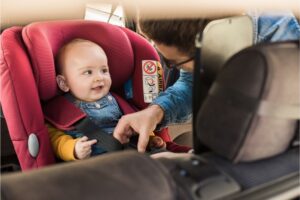Every lock for a car seat is designed differently; parents must know these small details to prevent any accidents as there are several cases in which parents failed to lock seat belts for child seats properly.
How should you lock a seat belt for a child seat?
Every vehicle is designed differently, and not every child restraint will fit well with the vehicle belts.
There are a couple of steps that you should follow to secure the child seat with the vehicle seat belt.
Firstly, make sure to check your vehicle manual for information.
The next thing you should decide is how to install the car seat in your vehicle, and lastly, make sure to check the retractor of your car to know how you will lock the child restraint.
Common things you should know for locking the seat belts of a child seat:
- How To Install The Car Seat
- Types Of Retractors In Car Seats
- Seat Belts Or Latches
- Securing Seat Belts On Different Child Seats
- Consequences Of Incorrect Installation
This article will assist you with the material that will be beneficial for you in the long run. You must read through the whole article to have a greater understanding.
With the correct knowledge and assistance, you will be proficient enough to perform this responsible task.
Table of Contents
5 Common Things You Should Know When Locking A Seat Belt For Your Child Seat

When installing your car seats, you might face minor inconveniences that might make the installation process long and confusing.
This is why it is important to know beforehand to make things easier.
In this article, I have listed everything you need to do to make locking your seat belts for child seats a simple and understandable task.
1. How To Install The Car Seat
The installation process is not as hard as you may think.
There are just a couple of things you need to keep in mind, such as what type of car you are using, the car seat is rear-facing or forward-facing.
It is also important for you to know what type of seat belts your car has, such as shoulder belts or latch belts.
To install your car seat, there are a couple of steps that you should follow, which are as follows:
- Make sure you know the right position to install the car seat in your car by reading the vehicle and car seat manual.
- The next step, place the car seat accordingly, and if you are using the seat belt, make sure to pull it all the way to test if the seat belt is locked.
- Next, put pressure and tighten the seat belts with one hand placed on the car seat.
- Finally, do the pinch test by moving the car seat front and back or side to side as there should only be 1-inch movement. If your car seat is not moving, then it means it is placed tightly.
- If the car seat is loose, make sure to pull the belts again to tighten it.
2. Types Of Retractors In Car Seats
You need to know what type of retractor is installed inside your vehicle to help you when it comes to installing your child’s car seat.
There are mainly two types of retractors that are designed for vehicles. Their purposes are to lock the seat belts in place and to prevent harsh injuries from happening during a crash.
Both perform the function of protecting you during a crash and securing you in place tightly, but their features are different.
However, now in the latest vehicles, you are allowed to switch from both types, so always make sure that you are using the ALR mode when securing a child seat.
The Automatic Locking Retractor (ALR)
This retractor is perfect if you have it installed in your car, as it is stated that ALR is the perfect fit for installing and protecting your car seats.
This function is also referred to as child restraint mode, so it is absolutely great if you have it in your car as it will provide proper protection.
In order to lock seat belts with this kind of retractor, you will have to start by pulling the seat belt all the way out from the retractor.
Once the seat belt is completely out, slowly start webbing back by 6 to 8 inches into the retractor.
If you notice and hear closely, you will hear a clicking sound which will indicate that the seat belt is now in locking mode.
If you are not sure whether it is locked or not, you can try to pull the seat belt out, and if it does not move, then it clearly means that it is locked in place.
This is also called a switchable retractor.
It is perfect for keeping your child’s restraint tight and secure and will not budge at all, especially during an accident, as they are best known and used for child seats.
The Emergency Locking Retractor (ELR)
This retractor is designed differently for seat belts.
The purpose of this retractor is also to protect you from an accident, and the functions are also the same as the ALR, but it works differently.
This retractor function only locks when there’s a rapid deranged movement that happens during an accident.
These types of the retractor in the seat belts do not function quickly because they keep the seat belts locked in place like ALR.
This type of retractor is not exactly ideal for your child’s car seat as it cannot be used to hold the child seat in place.
However, the great thing about this is that it can be locked immediately in a crash as the seat belts start rapidly coming out of the retractor.
Even though it is not ideal for car seats, they still protect your child from accidents and prevent injuries.
3. Seat Belts Or Latches
If you are someone who is using both the seat belts and latches at the same time for your child’s safety seat, then you must stop right now.
It is suggested for parents that if you have a latch system in your car, then only use a latch but if you have seat belts, then only use belts to keep your child’s seat securely in place.
However, if you do want to use both, then make sure to check your vehicle manual as well as the child’s car seat instruction manual to see if it allows you to use both at the same time, but the chances are quite low as there are barely any manufacturers who provide both systems to be used at the same time.
Unsafe Option When It comes To Latches
There are way too many disadvantages attached to the latch system as it is unsafe and many people suggest moving to seat belts to secure your child’s car seat in place.
There’s a weight limit on latches, and it is suggested that the weight it can hold is up to 65 pounds and not more than that.
Eventually, if you cannot find latches in your vehicle, then you will have to use seat belts, and it is preferably a better and safe option.
Furthermore, your child will not outgrow the seat belts weight limit. It is best for your child to only use seat belts as they are designed to be locked in place immediately.
The reason why you should not lock the car seat with seat belts and latches is that during an accident, the forces of crashes will locate pressure on the wrong side of the vehicle seat, which will result in the vehicle’s function stopping working properly.
As a result of this, instead of the car seat absorbing the crash forces, it can be directed through your child who can result in serious injuries to the sensitive parts of the body.
4. Securing Seat Belts On Different Child Seats
As I have mentioned earlier before you start to install your child’s safety seat, make sure to check if the ALR mode is on instead of the ELR.
If this option is available in your vehicle, then you are good to go. Even if you do not have the option, it is still fine as they both perform the functions to protect the car seat and your child.
Moving on, there are different ways in which you will have to install the car seat with the seat belts as there are different types of car seats out there to choose from.
1. Rear-Facing Car Seat
- Place your car seat on the vehicle.
- Make sure it is correctly placed by following the manufacturer’s instruction manual.
- Thread the seat belt through the correct belt path.
- Now you will have to buckle the seat belt.
- Start by pulling the seat belt and start webbing slowly back into the retractor.
- Once you hear a clicking sound, your seat belt is locked in place.
- Put pressure on the child’s car seat and start tightening the belt if needed.
2. Forward-Facing Car Seat
- The safest place to install the car seat is in the middle of the vehicle seat.
- Start by threading the vehicle’s shoulder lap belt through the correct belt path at the back of the seat slot.
- Engage with the seat belt locking following the ALR locking system (as mentioned earlier).
- Place the top tethers on the top of the seat; this can be installed by using seat belts.
- Finally tighten the seat belt and buckle your child and you are good to go!
3. Booster Car Seats
- Place and secure the child’s seat on your vehicle seat.
- Secure the lower anchor of the seat with your vehicle seat.
- Next, lock the seat belt with the ALR system.
- And lastly, use the shoulder and lap belt over the child’s upper thighs and the shoulder belt on the middle of your child’s chest. Then you are all set!
Related: How Should A Child Fit In A Booster Seat Properly?
5. Consequences Of Incorrect Installation
Seat belts are important for the safety of you and your children.
However, if it is used or installed incorrectly, it can be dangerous and can result in serious injuries on different parts of your body.
In the case of using seat belts for a child’s seat, it is noticed by child passenger safety technicians that many parents misuse the child’s car seat as the vehicle seat belt is not in the locked mode.
This can be dangerous, and there have been many children’s death cases resulting just from this.
There have been many cases in which children would mess around with the seat belts and start playing by pulling out too much seat belt, which can be dangerous in the long run as they can cause strangulation during a crash because seat belts can wrap easily around the child’s neck.
Moreover, the shoulder belt should always be placed in the middle of the chest area and should not be too close to your neck.
As for the lap belts, make sure to place them below the stomach, and the belt should be tight, not loose.
These might seem like basic things, but honestly, it is vital for everyone to follow these basic rules so they can be safe from serious injuries.
If a seat belt is used improperly, it can cause injuries to the abdomen, spinal cord, or shoulders.
In addition to that, always be sure of your vehicle retractors and to lock the seat belts, secure your child in place, and then start your vehicle.
Conclusion
Overall, it is important to always follow the proper rules when you are using a seat belt as it can protect you from serious injuries.
It is also important to teach your children valuable lessons by not playing with seat belts as they are not toys and are used for the purpose of protection.
As for parents, it is crucial to always lock their child’s car seats before starting their vehicle.
I hope this article was beneficial for you in understanding how to lock your seat belts for child seat.

I am Tahir Azam, and I have been writing amazing articles for TaxiHack for as long as I can remember. I know everything that is to know when it comes to automobiles and is always on top of industry news and developments. While I am not an expert by any means, I pride myself on knowing the ins and outs of many different problems and, of course, their solutions. The articles on our website are some of the best and well-researched content that you will find, and I spend countless hours making sure this remains to be true. This is why I ask you to take your time out and read some of my articles, especially if you find a topic that resonates with you or is something you are looking into. This way, you will find the perfect mix of information and tips on your desired topic. Learn more about Tahir.



